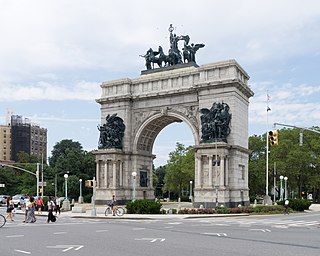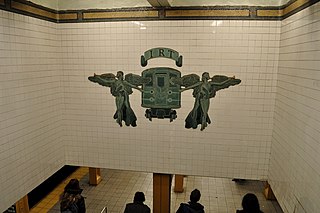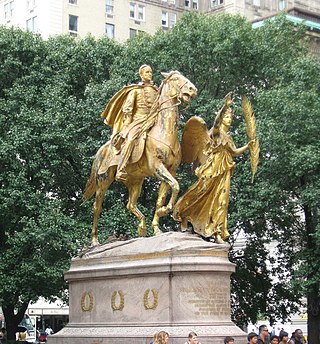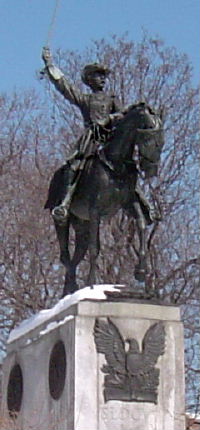
Grand Army Plaza, originally known as Prospect Park Plaza, is a public plaza that comprises the northern corner and the main entrance of Prospect Park in the New York City borough of Brooklyn. It consists of concentric oval rings arranged as streets, with the namesake Plaza Street comprising the outer ring. The inner ring is arranged as an ovoid roadway that carries the main street – Flatbush Avenue. Eight radial roads connect Vanderbilt Avenue; Butler Place; two separate sections of Saint John's Place; Lincoln Place; Eastern Parkway; Prospect Park West; Union Street; and Berkeley Place. The only streets that penetrate to the inner ring are Flatbush Avenue, Vanderbilt Avenue, Prospect Park West, Eastern Parkway, and Union Street.

The Grand Army Plaza station is a local station on the IRT Eastern Parkway Line of the New York City Subway. It is located in Park Slope, Brooklyn, underneath Flatbush Avenue at its intersection with Plaza Street West and St. Johns Place, on the northwest side of Grand Army Plaza. It is served by the 2 train at all times, the 3 train at all times except late nights, and the 4 train during late nights.

Augustus Saint-Gaudens was an Irish and American sculptor of the Beaux-Arts generation who embodied the ideals of the American Renaissance. Saint-Gaudens was born in Dublin to an Irish-French family, and raised in New York City. He traveled to Europe for further training and artistic study. After he returned to New York City, he achieved major critical success for his monuments commemorating heroes of the American Civil War, many of which still stand. Saint-Gaudens created works such as the Robert Gould Shaw Memorial on Boston Common, Abraham Lincoln: The Man, and grand equestrian monuments to Civil War generals: General John Logan Memorial in Chicago's Grant Park and William Tecumseh Sherman at the corner of New York's Central Park. In addition, he created the popular historicist representation of The Puritan.

Alexander Phimister Proctor was an American sculptor with the contemporary reputation as one of the nation's foremost animaliers.

Bela Lyon Pratt was an American sculptor from Connecticut.

Philip H. Martiny was a French-American sculptor who worked in the Paris atelier of Eugene Dock, where he became foreman before emigrating to New York in 1878—to avoid conscription in the French army, he later claimed. In the United States he found work with Augustus Saint-Gaudens, with whom he remained five years; a fellow worker in Saint-Gaudens' shop was Frederick MacMonnies. A group photograph taken in Saint-Gaudens's studio about 1883, conserved in the Archives of American Art, shows Kenyon Cox, Richard Watson Gilder, Martiny, Francis Davis Millet, Saint-Gaudens, Julian Alden Weir and Stanford White.

Albert Jaegers was an American sculptor.

Burt William Johnson was an American sculptor.

Grand Army Plaza is a square at the southeast corner of Central Park in Manhattan, New York City, at the intersection of Fifth Avenue and Central Park South, covering two blocks on the west side of Fifth Avenue between 58th and 60th Streets. It contains an equestrian statue of William Tecumseh Sherman on its northern half and the Pulitzer Fountain on its southern half.

The Puritan is a bronze statue by sculptor Augustus St. Gaudens in Springfield, Massachusetts, which became so popular it was reproduced for over 20 other cities, museums, universities, and private collectors around the world, and later became an official symbol of the city, emblazoned on its municipal flag. Originally designed to be part of Stearns Square, since 1899 the statue has stood at the corner of Chestnut and State Street next to The Quadrangle.

The James A. Garfield Monument is a monument honoring the 20th president of the United States in Philadelphia, Pennsylvania, United States. Sculptor Augustus Saint-Gaudens and architect Stanford White collaborated on the memorial, which was completed in 1896. It is located in Fairmount Park, along Kelly Drive, near the Girard Avenue Bridge.
Lawrence Joseph Nowlan Jr. was an American sculptor and figurative artist known for his statues of notable individuals, including Harry Kalas and Jackie Gleason. Nowlan also designed memorials, including the firefighter sculptures at the Wildland Firefighters National Monument in Boise, Idaho, which was his first commission as a sculptor, and the war memorial in Windsor, Vermont. Additionally, Nowlan created the statuette awarded by several major ceremonies, including the ESPN ESPY Award and the My VH1 Music Awards. He was working on an 8-foot, 800 pound statue of Philadelphia boxer, Joe Frazier, at the time of his death in 2013.

William Tecumseh Sherman, also known as the Sherman Memorial or Sherman Monument, is a sculpture group honoring William Tecumseh Sherman, created by Augustus Saint-Gaudens and located at Grand Army Plaza in Manhattan, New York. Cast in 1902 and dedicated on May 30, 1903, the gilded-bronze monument consists of an equestrian statue of Sherman and an accompanying statue, Victory, an allegorical female figure of the Greek goddess Nike. The statues are set on a Stony Creek granite pedestal designed by the architect Charles Follen McKim.

The Willink Entrance area, also known as Willink Plaza, is a major urban square of Brooklyn, New York City, formed by the intersection of Flatbush Avenue, Ocean Avenue and Empire Boulevard, at the eastern corner of Prospect Park and the southern corner of the Brooklyn Botanic Garden. It is serviced by the New York City Subway's Prospect Park station, and features several public spaces and historic buildings. This location is considered the northwestern point of the Prospect Lefferts Gardens neighborhood of Flatbush, and adjoins Crown Heights to its northeast.
Neil Carl Estern was an American sculptor. Known for his public monuments, Estern's best-known works are his sculptures of Franklin D. Roosevelt, Eleanor Roosevelt, and Fala at the Franklin Delano Roosevelt Memorial in Washington. Estern was also the creator of Patti Playpal.

The equestrian statue of Henry Warner Slocum is a monumental statue in Brooklyn's Grand Army Plaza, in New York City. The equestrian statue, designed by sculptor Frederick William MacMonnies, was dedicated in 1905 in honor of Henry Warner Slocum, who served as a general in the Union Army during the American Civil War and later as a U.S. Representative from the state of New York.

Hettie Anderson was an African-American art model and muse who posed for American sculptors and painters including Daniel Chester French, Augustus Saint-Gaudens, John La Farge, Anders Zorn, Bela Pratt, Adolph Alexander Weinman, and Evelyn Beatrice Longman. Among Anderson's high-profile likenesses are the winged Victory figure on the Sherman Memorial at Grand Army Plaza in Manhattan, New York City and $20 gold coins known as the Saint-Gaudens double eagle. Theodore Roosevelt deemed Victory "one of the finest figures of its kind." Saint-Gaudens described Anderson as "certainly the handsomest model I have ever seen of either sex" and considered her "Goddess-like."

Major General David McMurtrie Gregg is a monumental statue located in Reading, Pennsylvania, United States. The monument was designed by Henry Augustus Lukeman and consists of an equestrian statue depicting David McMurtrie Gregg, a military officer who had served in the Union Army during the American Civil War. The monument was dedicated in 1922, several years after Gregg's death in Reading in 1916.

The Christopher Lyman Magee Memorial is a public memorial in the Oakland neighborhood of Pittsburgh, Pennsylvania, United States. Located outside of the Carnegie Library of Pittsburgh in Schenley Park, the memorial honors Christopher Magee, a local political boss and philanthropist during the late 1800s. It was designed by sculptor Augustus Saint-Gaudens, with assistance from Henry Hering, while Stanford White and Henry Bacon served as architects for the project. The memorial was dedicated on Independence Day, July 4, 1908, before a crowd of two thousand spectators. It was one of the last works created by Saint-Gaudens, who died several months before its dedication.


















